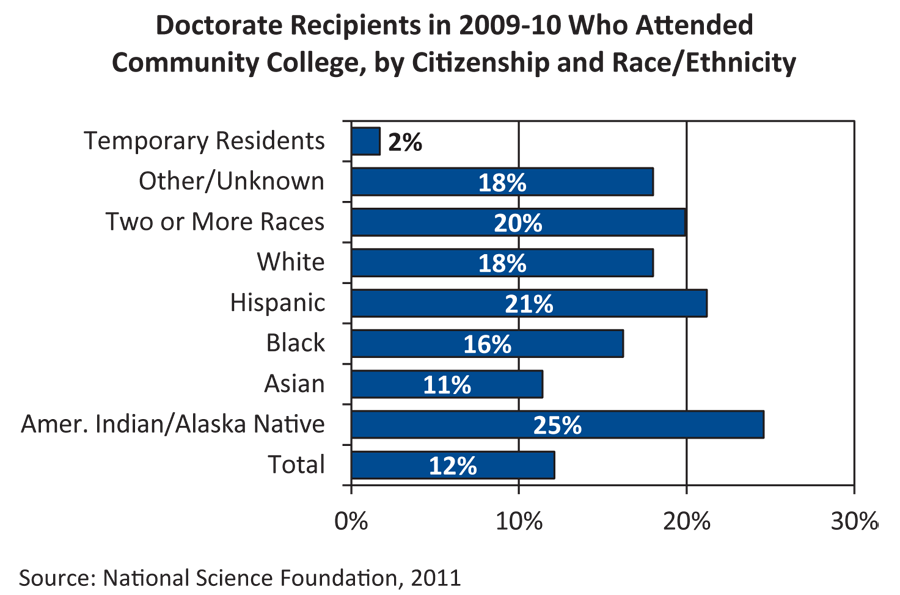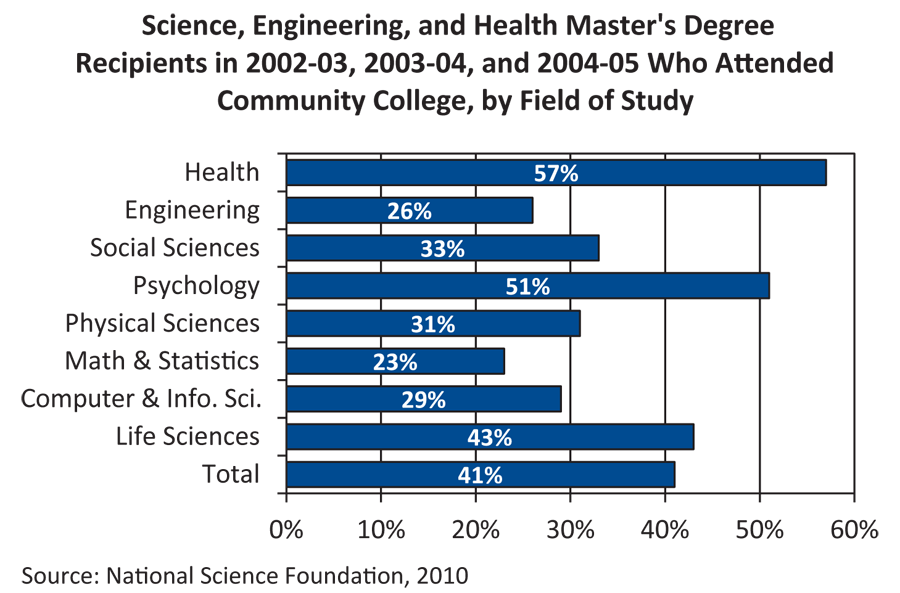You are on CGS' Legacy Site.
Thank you for visiting CGS! You are currently using CGS' legacy site, which is no longer supported. For up-to-date information, including publications purchasing and meeting information, please visit cgsnet.org.
(Reprinted from the January/February 2012 issue of GradEdge)
For many students, the academic journey leading to a graduate degree starts with community college. These institutions provide access to higher education for students who in some cases may not yet even realize that a master’s degree or a doctorate is attainable. For other students, community colleges provide an affordable and/or a convenient means of earning college credit prior to enrolling, or even while enrolled, in a four-year institution.
In fall 2009, more than 7.5 million students were enrolled at two-year colleges in the United States (Snyder and Dillow, 2011). This figure reflects a rapid expansion in two-year college enrollment over the past decade, with an increase of more than one-third (34%) between 1999 and 2009. The majority (57%) of two-year college enrollees in fall 2009 were enrolled part-time.
Community colleges play an important role for students who are underrepresented in higher education. For example, two-year institutions enroll higher percentages of first generation college students than four-year institutions, as well as higher percentages of low socioeconomic status students and older students (Provasnik and Planty, 2008). These institutions also are important pathways to degree attainment for underrepresented minorities (African Americans, Hispanics, and Native Americans), since individuals from these racial/ethnic groups account for a higher percentage of the enrollees at two-year colleges than at four-year colleges. African Americans comprised 15% of the enrollees at two-year colleges in fall 2009, compared with 14% at four-year colleges. Hispanics comprised 17% of the enrollees at two-year colleges, compared with just 10% at four-year colleges, and Native Americans accounted for 1.2% of the enrollees at two-year colleges, compared with 0.9% at four-year colleges (Snyder and Dillow, 2011).
While two-year institutions serve higher percentages of underrepresented students, not all students attending these institutions do so with the intention of earning a degree. About 43% of two-year college attendees plan to complete an associate’s degree, and about 36% plan to transfer to a four-year institution (Provasnik and Planty, 2008). Many of the degree-seeking students, however, will fail to earn an associate’s degree or transfer to a four-year institution. The current degree completion rate at community colleges is just 28%, meaning that nearly three-quarters of all two-year college attendees fail to earn a certificate or a degree within 150% of the expected normal time to completion (Snyder and Dillow, 2011). And only about one in five students (21%) will transfer to a four-year institution within five years of enrolling at a community college (National Center for Education Statistics, 2011).
Despite the low completion and transfer rates for students at two-year institutions, data on recent doctorate recipients show that community college attendance can lead to graduate degree attainment. Among doctorate recipients in academic year 2009-10, 12% had earned college credit from a community or two-year college at some point on their academic path (National Science Foundation, 2011). These individuals may have taken just one course or may have earned a certificate or an associate’s degree from a two-year college. Women who earned their doctorates in 2009–10 were slightly more likely than men to have attended a two-year college at some point: 13.3% of women vs. 11.0% of men. Among US citizens and permanent residents, American Indians/Alaska Natives (25%) and Hispanics (21%) were most likely to have attended a two-year college (see Figure 1). In contrast, just 2% of temporary resident doctorate recipients in 2009–10 attended a two-year college at some point.
Figure 1

Individuals who earned a doctorate in education were most likely to have earned college credit from a community or two-year college (see Figure 2). One out of five doctorate recipients in education in 2009–10 had attended a two-year college at some point, along with 14% of those in social sciences, and 13% of those in both humanities and life sciences. Engineering doctorate recipients were least likely to have attended a community college, with just 7% reporting having done so.
Figure 2

Community college attendance is even more prevalent among recent master’s degree recipients. Among individuals who earned master’s degrees in science, engineering, or health fields in academic years 2002–03, 2003–04, and 2004–05 (the most recent data available), 41% had taken at least one course at a community college at some point (National Science Foundation, 2010). As shown in Figure 3, master’s degree recipients in health fields were most likely to have taken a course at a two-year college (57%), and master’s degree recipients in mathematics and statistics were least likely to have done so (23%).
Figure 3

The findings are similar among recent bachelor’s degree recipients. Half (50%) of the individuals who earned bachelor’s degrees in science, engineering, or health fields in academic years 2002–03, 2003–04, and 2004–05 had attended a community college at some point (National Science Foundation, 2010). Bachelor’s degree recipients in health fields were again most likely to have taken a course at a two-year college (67%), while bachelor’s recipients in mathematics and statistics were again least likely to have done so (42%).
The data clearly show that many students who attend two-year colleges will eventually go on to earn bachelor’s degrees, master’s degrees, and doctorates. Getting more of the students who attend two-year institutions to go on to earn advanced degrees could help diversify the graduate student population. With higher percentages of underrepresented minorities, low socioeconomic status students, and first generation college students attending two-year institutions than four-year institutions, community colleges are an important source of tomorrow’s graduate students.
By Nathan E. Bell, Director, Research and Policy Analysis, Council of Graduate Schools
References:
National Center for Education Statistics. (2011). Community College Student Outcomes: 1994-2009. Retrieved from http://nces.ed.gov/pubs2012/2012253.pdf.
National Science Foundation. (2010). Characteristics of Recent Science and Engineering Graduates: 2006. Retrieved from http://www.nsf.gov/statistics/nsf10318/.National Science Foundation. (2011).
Doctorate Recipients from U.S. Universities: 2010. Retrieved from http://www.nsf.gov/statistics/sed/start.cfm.
Provasnik, S., and Planty, M. (2008).
Community Colleges: Special Supplement to The Condition of Education 2008. National Center for Education Statistics, Institute of Education Sciences, US Department of Education: Washington, DC.
Snyder, T.D., and Dillow, S.A. (2011). Digest of Education Statistics, 2010. National Center for Education Statistics, Institute of Education Sciences, US Department of Education: Washington, DC.




